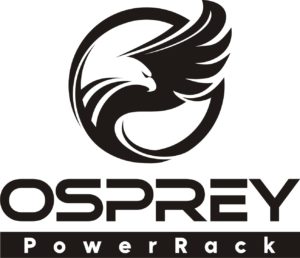Types of Ground-Mount Solar Systems
Key Takeaways
- Ground-mount solar systems come in several main types: standard ground mounts, pole mounts, and tracking systems.
- Ground-mount solar systems offer significant flexibility in panel orientation and can be installed on a variety of terrains
- Choosing the right foundation – whether concrete, anchor, or hybrid – based on soil and terrain conditions is crucial for the stability, cost-efficiency, and longevity of solar installations.
- The choice between traditional ground mounts, pole mounts, and tracking systems should be guided by factors such as budget, available space, energy needs, and site-specific conditions.
- Nuance Energy’s multi-patented earth anchor foundation technology doesn’t require heavy equipment and concrete, dramatically cutting installation costs and time while increasing efficiency and profitability for solar installers.
| Nuance Energy is your superior solution for Ground Mount solar. Our patented foundation technology Osprey PowerRACK® allows for rapid installation using only handheld tools, significantly reducing both time and costs compared to traditional racking systems. This cutting-edge technology works for residential and commercial installations, and Nuance Energy empowers solar installers to take back control of their installation schedules, control project COGS, gain market share, increase the speed of install, and reduce cost of labor. In contrast, a traditional ground mount is much more unpredictable, slower, and costly.
Find out how Nuance Energy can accelerate your solar projects with the Osprey PowerRACK® line, and boost your profitability. Contact us today to discuss our innovative ground-mount solutions. |
Introduction
Ground-mount solar systems are an excellent option for generating renewable energy, offering significant flexibility and efficiency regardless of the available land area. Unlike rooftop solar systems, which are static, ground mounts allow for optimal panel orientation and easier maintenance. We’ll review the different types of ground-mount solar systems, their benefits, and how to choose the right one for your needs.
Types of Ground-Mount Solar Systems
Traditional Ground Mounts
Standard ground mounts are the most common type of ground-mount solar system. They consist of a simple frame that holds the solar panels at a fixed angle, usually optimized for the location’s latitude and slope. These systems are popular because they are:
- Cost-effective: Offering an affordable solution for both residential and commercial applications.
- Easier to install: Requiring less specialized equipment and labor compared to more complex systems.
- Suitable for residential and small commercial projects: These systems can be adapted to various site conditions with different foundation types, ensuring stability and performance even in challenging environments.
Traditional ground mounts can be configured with various foundation options, each customized to specific soil conditions and project requirements:
Anchor Foundations
- Ground Screws: Large screws drilled directly into soft soil, providing a stable base for the solar array.
- Helical Piles: Helical-shaped piles twisted into the ground, suitable for various soil types, including loose or sandy soils.
- Driven Piles: Steel or aluminum beams driven into the ground, commonly used in large-scale solar projects.
Concrete Foundations
- Ballasted Foundations: Concrete blocks or slabs placed on the ground, ideal for rocky or uneven terrain where ground penetration is difficult.
- Pier Foundations: Concrete piers poured into pre-dug holes, offering a permanent and stable foundation.
- Pre-cast Concrete Footings: Pre-fabricated concrete blocks placed on or partially buried in the ground for quick and simple installation.
Auger Foundations
- Auger Foundation Mounts: Large screw-type augers drilled into softer soils, providing a solid foundation similar to helical piles.
Hybrid Foundations
- Combination Methods: Use a mix of ground screws, ballast, or other techniques to ensure stability in challenging terrains.
Floating Foundations
- Floating Foundation Mounts: Designed for marshy or very soft ground, using shallow concrete pads and anchors to support the solar array.
Rammed Earth or Stone Foundations
- Local Materials: Foundations made from rammed earth or stone, ideal in regions where traditional materials are scarce or expensive.
Adjustable Foundations
- Adjustable Foundation Mounts: Allow for post-installation height adjustments, useful in areas prone to settling or with uneven terrain.
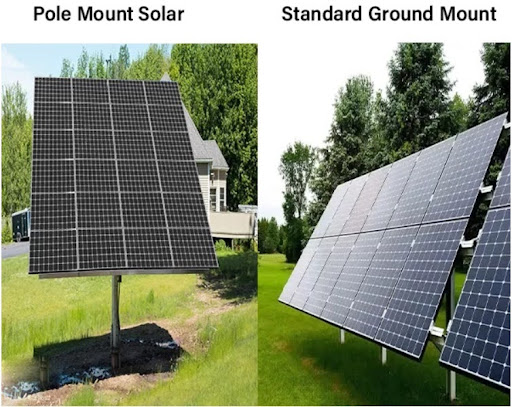
Pole Mount (left) offers elevated flexibility in panel orientation, while Standard Ground Mount (right) provides a cost-effective and stable solution for solar installations (image courtesy of SolarSME).
Pole Mounts
Pole mounts offer greater flexibility in panel orientation – the solar panels are mounted on top of poles, which can be either fixed or adjustable. These systems are suitable for areas with limited space because they can be installed at different heights and angles. Benefits of pole mounts include:
- Better sun exposure
- Flexibility in panel orientation
- Space-saving design
Pole mounts are generally more expensive than standard ground mounts due to the additional materials and complexity involved in the installation.
They are available in various configurations, each offering unique advantages in terms of installation and performance.
Standard Pole Mounts
- Single-Pole Mounts: Solar panels mounted on a single vertical pole, with fixed or manually adjustable angles. Suitable for small to medium-sized arrays.
- Multi-Pole Mounts: Multiple poles supporting larger arrays, providing stability and customization for specific site conditions.
Top-of-Pole Mounts
- Elevated Mounting: Panels are mounted at the top of a pole, useful in areas with limited space or where shading needs to be minimized.
Adjustable Pole Mounts
- Tilt Adjustment: Allows manual or automated tilt adjustments to optimize energy capture based on seasonal sun angles.
Tracking Systems
Tracking systems are the costliest & advanced type of ground-mount solar system – they use motors and sensors to follow the sun’s path throughout the day, maximizing energy production.
There are two main types of tracking systems: single-axis and dual-axis.
Single-Axis Trackers
- Movement: Rotates panels on one axis, typically from east to west.
- Energy Yield: Increases energy yield by 20-30% compared to fixed systems.
- Cost: Less expensive than dual-axis trackers due to simpler mechanics.
- Complexity: Easier to install and maintain than dual-axis systems.
- Best For: Projects with moderate energy needs where maximizing output is important but budget and simplicity are also considerations.
Single-axis tracking Systems follow the sun’s east-west path, allowing for a significant increase in the collection of solar energy throughout the day.
Dual-Axis Trackers
- Movement: Rotates panels on two axes – both north-south and east-west.
- Energy Yield: Offers up to 40% more energy yield compared to fixed systems, providing the highest possible energy production.
- Cost: More expensive due to the complexity of the system and additional components.
- Complexity: Requires more precise installation and regular maintenance to ensure optimal performance.
- Best For: Large commercial or utility-scale projects where the highest energy production justifies the higher upfront costs and maintenance requirements.
Single-Axis Tracking Systems
- Horizontal Single-Axis Trackers (HSAT): The array rotates around a single horizontal axis (north-south), following the sun from east to west. Increases energy yield by 20-30%.
- Tilted Single-Axis Trackers (TSAT): Similar to HSAT but with a tilted axis for optimized solar exposure, particularly in higher latitudes.
Dual-Axis Tracking Systems
- Full Sun Tracking: Tracks the sun’s movement in two directions (east-west and up-down), keeping panels directly facing the sun. Offers up to 40% more energy yield compared to fixed systems but with higher costs and complexity.
Advanced Tracking Systems
- Azimuth Trackers: Follow the sun’s horizontal (azimuth) and vertical (altitude) angles, typically used in high-efficiency solar farms.
- Backtracking Systems: Adjust angles to prevent shading from adjacent rows in densely packed arrays, optimizing energy production.
Choosing the Right System
- Budget: Consider your project’s material costs & labor. Standard ground mounts are the most cost-effective with relatively lower material and labor costs when compared to tracking systems
- Space: Pole mounts are ideal for limited space, while standard ground mounts may require a greater footprint
- Energy Needs: Tracking systems offer the highest energy production but come at a higher cost.
- Soil and Terrain Conditions: The suitability of your land’s soil and terrain plays a crucial role in determining the best system & foundation
- Geotechnical Report: Based on the type of system you choose, you may be required to obtain a geotechnical report, which contains detailed information about the soil composition, load-bearing capacity, and potential challenges such as erosion or water drainage issues.
- Timeline and Scheduling: The complexity of the system you choose will directly affect the installation timeline.
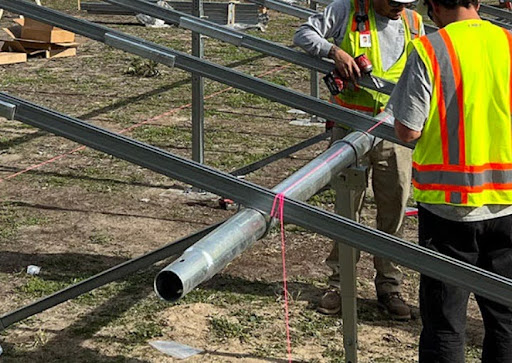
Selecting the optimal ground-mount solar system requires balancing between budget, space, and energy needs to ensure optimal efficiency and output.
Foundation Types and Their Impact
Budget:
- Standard Ground Mounts: These systems are the most cost-effective option, offering a solid balance between initial investment and energy production. They are particularly suitable for residential and small commercial projects where budget constraints are a primary consideration.
- Pole Mounts: Generally more expensive than standard ground mounts due to the additional materials and complexity involved in installation. However, their potential to maximize energy production in limited spaces can justify the higher cost in specific scenarios, such as small or irregularly shaped plots of land.
- Tracking Systems: The most expensive option, tracking systems involve higher upfront costs due to their advanced technology, including motors and sensors. However, the increased energy yield can offset these costs over time, making them a viable choice for large commercial or utility-scale projects where maximizing energy output is crucial.
Space:
- Standard Ground Mounts: These systems typically require more land area, making them ideal for sites with ample space. However, recent advancements allow for more compact designs that can fit smaller or irregular plots, though this may still require careful planning to avoid shading and optimize performance.
- Pole Mounts: Pole mounts are ideal for limited space, as they allow panels to be elevated and angled for optimal sun exposure, reducing the overall footprint. This makes them particularly useful in areas where ground space is at a premium, or where the terrain makes traditional ground mounts impractical.
- Tracking Systems: Tracking systems require more space for the panels themselves and for the movement mechanisms that follow the sun throughout the day. Additionally, to avoid shading from adjacent rows, tracking systems demand careful layout planning, which increases the overall land requirement. However, they offer the highest energy density per square foot, making them valuable in scenarios where maximizing output per unit area is the priority.
Energy Needs:
- Standard Ground Mounts: Provide stable and predictable energy production, making them suitable for consistent, moderate energy needs. These systems are often optimized for the location’s latitude, ensuring a good balance between simplicity and efficiency.
- Pole Mounts: While offering similar energy output to standard ground mounts, pole mounts can be adjusted for better sun exposure, particularly in areas with challenging terrain or partial shading. This flexibility can lead to slightly higher energy production, particularly when manual or automated tilt adjustments are incorporated.
- Tracking Systems: Offer the highest energy production by following the sun’s path throughout the day. Single-axis trackers can increase energy yield by 20-30%, while dual-axis trackers can boost it by up to 40%. These systems are ideal for projects where maximizing energy output is critical, such as in large-scale commercial installations where the higher initial investment can be offset by the increased energy production and reduced cost per watt over time.
Soil and Terrain Conditions:
- Concrete Foundations: Work best in rocky or uneven terrain where stability is crucial. They provide a strong, durable base but require more time and resources to install.
- Anchor Foundations (Ground Screws or Helical Piles): Ideal for soft soils where traditional concrete foundations may not be feasible. These can be installed more quickly and with less disturbance to the site, making them a cost-effective option in the right conditions.
Geotechnical Report:
- Essential for understanding the soil composition and load-bearing capacity of your site. For example:
- Soft Soils: May require anchor foundations like ground screws or helical piles to ensure stability.
- Rocky Terrain: Might necessitate the use of concrete foundations to secure the mounting system.
Timeline and Scheduling:
- Standard Ground Mounts: Generally have a shorter installation timeline due to the straightforward nature of their design and foundation requirements.
- Tracking Systems: Installation may take longer due to the complexity of the moving parts and the need for precise calibration. Additionally, if anchor foundations are required, this can extend the timeline further.
- Pole Mounts: Can be quicker to install in areas with limited space but may require additional time if the terrain is challenging.
Benefits of Ground-Mount Solar Systems
- Flexibility in Location: Unlike rooftop systems, ground mounts can be placed anywhere on your property, allowing you to choose the optimal location for maximum sunlight exposure.
- Ease of Maintenance: Ground-mounted panels are easier to access for cleaning and maintenance.
- Cooling Effect: Ground-mounted panels have better airflow around them, which keeps the panels cooler and more efficient.
- Scalability: Ground-mount systems can be easily expanded if you decide to increase your energy production in the future.
Cost Considerations
- System Type: Standard ground mounts are the least expensive, while tracking systems are the costliest option due to their complexity and additional components.
- Installation: The cost of installation includes labor, equipment, and any necessary site preparation, such as grading or trenching for electrical conduits.
- Permitting and Inspections: Depending on your location, you may need to obtain permits and undergo inspections, which adds to the overall cost.
To give you a better idea of the costs, here’s a comparison table:
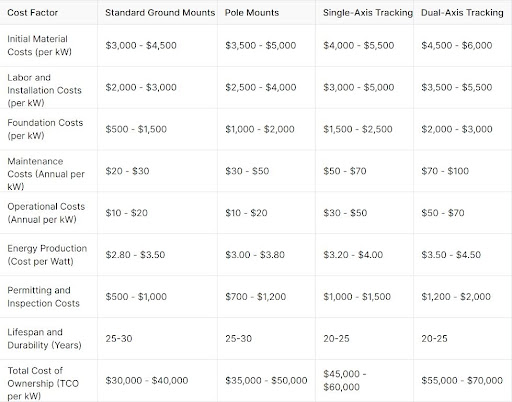
The prices provided are estimates and are accurate as of the time of writing. Actual costs may vary depending on the specific requirements and conditions of each individual project.
Environmental Impact
Ground-mount solar systems have a positive environmental impact as they lower the reliance on fossil fuels for energy generation and curtail greenhouse gas emissions. Additionally, they can be installed on otherwise unusable land, such as brownfields or reclaimed mining sites, which further contributes to their environmental benefits.
Ground-mount systems can also contribute to local biodiversity: by planting native vegetation around and under the panels, you can create habitats for local wildlife and promote soil health.
They can interfere with some wildlife though (potentially blocking migration routes), but that’s generally the case for truly massive systems. Similar concerns exist in terms of the use of the land, as agricultural activities may also be interrupted – but again that depends on a case by case basis and it’s unusual for solar panels to be installed on rich fertile agricultural land.
Nuance Energy – A Leading Distributor Of Ground-Mount Solar Racking Systems
Nuance Energy is a leader in providing innovative ground-mount solar racking systems. Our patented technology allows for quick and easy installation with just handheld tools, eliminating the need for heavy equipment and concrete. As such, our systems curtail installation costs and allow installers to scale up their operations and complete more projects faster.
Advanced Modular Ground-Mount Systems
Nuance Energy’s OSPREY PowerRack® racking system is an advanced modular ground-mount technology that offers flexibility, ease of installation, and scalability.
Our innovative solution is particularly well-suited for projects in remote areas, challenging terrains, and temporary installations where traditional solar racking systems may be impractical or too costly.
Advantages of OSPREY PowerRack® include:
- Modular Design: OSPREY PowerRack® is built with a modular approach, allowing it to be customized and scaled based on the specific needs of any project.
- Rapid Deployment: One of the key benefits of OSPREY PowerRack® is its ability to be rapidly deployed with minimal equipment – the system’s design eliminates the need for heavy machinery, reducing both installation time and costs.
- Scalability: OSPREY PowerRack® can be easily expanded or reconfigured as project requirements evolve.
- No Geotechnical Reports Required: A unique benefit of the OSPREY PowerRack® is its patented real-time soil condition anchor “load testing” technology, which eliminates the need for geotechnical reports. This innovation sets it apart from conventional solar ground mount systems, further streamlining the installation process.
- Predictable Project Costs and Time for Installation: The technology provides predictable project costs as the installation does not require geotech reports.

Nuance Energy’s patented earth anchor foundation technology substantially simplifies ground-mounted solar system installation, eliminating the need for heavy equipment and concrete foundations.
The Osprey PowerRack® system offers several unique features that align with the ground-mount types discussed earlier:
- Anchor Foundations: The Osprey PowerRack® can be installed using earth anchors, which are similar to ground screws or helical piles. These anchors provide stability without the need for concrete foundations, making the system ideal for sites with softer soils or where minimizing environmental impact is important.
- No Concrete Foundation Required: One of the key selling points of Nuance Energy’s system is its potential to avoid the use of concrete altogether. This reduces installation time, cost, and environmental impact, making it an efficient solution for many projects.
- Modular and Scalable Design: The system is designed to be modular and scalable, meaning it can be adapted to small, medium, or large solar arrays. This flexibility aligns with both single-pole and multi-pole mount systems, depending on the project size.
- Ease of Installation: The Osprey PowerRack® is designed for rapid deployment. It can be installed by a small crew without heavy machinery, which is a significant advantage in remote or difficult-to-access locations.
Compatibility with Tracking Systems:
While Nuance Energy primarily focuses on fixed tilt systems, the modular nature of the Osprey PowerRack® allows for integration with certain types of tracking systems. For instance:
- Single-Axis Trackers: Although not a core focus, the platform can be adapted to support single-axis tracking systems, particularly in projects where optimizing energy yield is crucial. The modular design can accommodate the additional hardware required for tracking.
Applications and Use Cases
Nuance Energy’s systems are particularly well-suited for:
- Commercial and Industrial Projects: The flexibility and scalability of the Osprey PowerRack® make it ideal for commercial and industrial solar installations, where ground conditions can vary significantly.
- Agricultural and Rural Installations: The ease of installation and the potential to avoid concrete make it a preferred choice for agricultural or rural areas where traditional foundations might be impractical or too costly.
- Temporary or Semi-Permanent Installations: Because of its non-permanent anchoring system, the Osprey PowerRack® is also used in projects that require temporary or semi-permanent solar installations, such as disaster relief efforts or temporary power needs.
Environmental and Cost Benefits
- Reduced Environmental Impact: By avoiding concrete and using minimally invasive earth anchors, Nuance Energy’s systems are designed to minimize their environmental footprint. This is particularly important in sensitive areas or where land restoration is a priority.
- Cost Efficiency: The reduction in labor, materials (no concrete), and equipment (no heavy machinery required) translates to significant cost savings, making Nuance Energy’s solutions very competitive in the market.
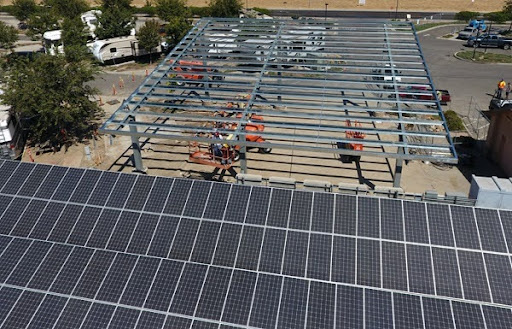
Nuance Energy’s ground-mount solar systems are a versatile solution designed for quick installation, adaptability to various terrains, and optimized solar energy production.
At Nuance Energy, we are dedicated to providing high-quality, cost-effective solutions for residential and commercial solar installations. Let us help you harness the power of the sun with our innovative ground-mount solar racking systems!
Visit our website to learn more about our system and request a quote.
Frequently Asked Questions (FAQ)
What are the main differences between ground-mount and rooftop solar systems?
Ground-mount solar systems are installed on the ground, offering more flexibility in panel orientation and easier access for maintenance, while rooftop systems are limited by roof space and angle.
How much land is needed for a ground-mount solar system?
The amount of land required depends on the size of the system, but generally, a typical residential ground-mount system requires about 100-400 square feet of space per kW of solar panels.
Are ground-mount systems more expensive than rooftop systems?
Ground-mount systems can be more expensive due to additional costs for mounting structures and land preparation, but they often offer higher energy production and greater flexibility.
What maintenance is required for ground-mount solar systems?
Ground-mount solar systems require regular cleaning of panels, inspection of mounting structures, and vegetation control around the installation site to ensure optimal performance.
Can ground-mount systems be installed on uneven or rocky terrain?
Yes, ground-mount systems, especially those with specialized foundations like Nuance Energy’s earth anchors, can be installed on uneven or rocky terrain with proper site assessment and preparation.
How do ground-mount systems perform in extreme weather conditions?
Ground-mount systems are designed to withstand extreme weather, but their performance can vary based on the system design, local climate, and proper maintenance. Elevated systems may be necessary in flood-prone areas.
Save Time & Money on Your Next Solar Project
Request a QuoteRECENT POSTS
- DPW Solar vs Nuance Energy Mounted Solar Options: Cost & Benefits
- Geotechnical Report Cost & Requirements For Solar Projects
- Are Solar Panels Worth It In Nevada? Costs & Options
- OSPREY PowerRack Ground Mount System Compatibility: Single- and Dual-Axis Trackers
- Rammed Earth Foundation For Solar Arrays: Cost, Pros & Cons
- Agrivoltaics Explained: Solar & Agriculture Combined
- Large Scale Solar Systems Options: Pros & Cons
- Best Solar Options For Farms & Agriculture: Cost, Pros & Cons
- Unirac vs MT Solar Mounted Options: Cost & Benefits
- IronRidge vs Grengy Mounted Solar Options: Cost & Benefits

